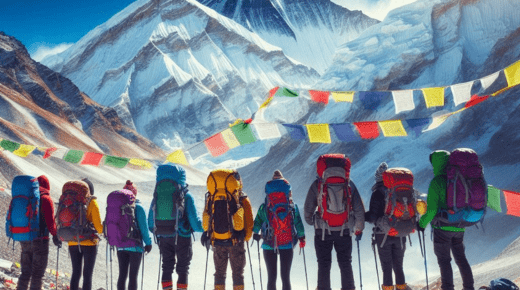Embarking on an Everest Base Camp Trek is a dream adventure for many trekkers and mountain enthusiasts around the globe. This journey offers not only the thrill of walking in the footsteps of legendary climbers but also an unparalleled view of some of the world’s highest peaks. Here, we present a comprehensive guide to help you plan and execute an unforgettable trek to Everest Base Camp.
Why Choose the Everest Base Camp Trek?
The Everest Base Camp (EBC) Trek is renowned for its breathtaking scenery, rich cultural experiences, and the sheer exhilaration of standing at the foot of the world’s tallest mountain, Mount Everest. This trek is not just about reaching a destination; it’s about the journey through the heart of the Khumbu region.

Best Time to Trek to Everest Base Camp
Spring (March to May)
Spring is one of the best times to undertake the Everest Base Camp Trek. The weather is relatively stable, and the temperatures are warmer. The blooming rhododendrons and other wildflowers add a splash of color to the landscape, enhancing the beauty of the trek.
Autumn (September to November)
Autumn is another excellent time for the trek. The skies are usually clear, offering spectacular views of the mountains. The weather is also stable, making it ideal for trekking.
Winter (December to February)
While it is possible to trek in winter, the conditions can be harsh. The temperatures drop significantly, and there is a higher chance of snow blocking the passes. However, for those who can brave the cold, the solitude and serene beauty of the winter landscape can be rewarding.
Monsoon (June to August)
The monsoon season is not ideal for trekking due to heavy rains, slippery trails, and a high chance of landslides. The views are often obscured by clouds, and the trails are less crowded.
Preparing for the Trek
Physical Fitness
The Everest Base Camp Trek is challenging and requires a good level of physical fitness. It is recommended to start training at least three months before your trek. Cardiovascular exercises, strength training, and hiking with a backpack are essential to prepare your body for the trek.
Permits and Documentation
To trek to Everest Base Camp, you will need the following permits:
- Sagarmatha National Park Entry Permit
- TIMS (Trekkers’ Information Management System) Card
These permits can be obtained in Kathmandu or through a trekking agency.
Packing Essentials
Packing the right gear is crucial for a successful trek. Here is a list of essentials:
- Trekking Boots: Comfortable and broken-in.
- Clothing: Layered clothing, including base layers, insulation layers, and a waterproof jacket.
- Sleeping Bag: Rated for -20°C or lower.
- Backpack: 50-70 liters capacity.
- Trekking Poles: To aid in stability on uneven terrain.
- First Aid Kit: Including altitude sickness medication.
- Other Essentials: Sunglasses, sunscreen, water purification tablets, and a headlamp.

The Trekking Route
Lukla to Phakding
The trek starts with a flight from Kathmandu to Lukla, followed by a hike to Phakding. This part of the trek helps in acclimatization as you gradually gain altitude.
Phakding to Namche Bazaar
From Phakding, the trail follows the Dudh Kosi River and leads to the bustling town of Namche Bazaar, the gateway to the high Himalayas. Namche Bazaar is an excellent place to acclimatize with its various shops, cafes, and stunning views of the mountains.
Namche Bazaar to Tengboche
The trek continues through forests and villages to Tengboche, home to the famous Tengboche Monastery. This monastery offers a serene and spiritual atmosphere with panoramic views of Everest, Ama Dablam, and other peaks.
Tengboche to Dingboche
Ascending further, the trail passes through rhododendron forests and across suspension bridges to reach Dingboche, a village surrounded by majestic peaks. Dingboche is another important acclimatization stop.
Dingboche to Lobuche
From Dingboche, the trek becomes more challenging as you climb towards Lobuche. The landscape becomes more barren and rugged, with stunning views of Nuptse, Pumori, and other peaks.
Lobuche to Gorak Shep and Everest Base Camp
The final leg of the trek takes you to Gorak Shep, the last stop before reaching Everest Base Camp. From Gorak Shep, it’s a challenging but rewarding hike to Everest Base Camp, where you can bask in the glory of the world’s highest peak.
Gorak Shep to Kala Patthar
A pre-dawn trek from Gorak Shep to Kala Patthar offers the best panoramic views of Everest and the surrounding peaks. The sunrise view from Kala Patthar is an unforgettable experience.
Descent to Lukla
After visiting Everest Base Camp and Kala Patthar, the trek descends back to Lukla, retracing your steps through the beautiful Khumbu region.
Cultural Experiences
Sherpa Culture
The Khumbu region is home to the Sherpa community, renowned for their mountaineering skills and warm hospitality. Along the trek, you will have the opportunity to experience Sherpa culture, visit monasteries, and learn about their traditions and way of life.
Monasteries
Visiting monasteries like Tengboche and Pangboche provides insight into the spiritual life of the Sherpas. These monasteries are important cultural and religious centers in the region.
Local Cuisine
Tasting local dishes such as dal bhat, momos, and Sherpa stew is an integral part of the trekking experience. The teahouses along the trail offer a variety of local and international cuisines.
Health and Safety Tips
Altitude Sickness
Acclimatization is crucial to prevent altitude sickness. It’s important to ascend slowly, take rest days, stay hydrated, and listen to your body. Symptoms of altitude sickness include headaches, nausea, and dizziness. If symptoms persist, it’s essential to descend to a lower altitude.
Hydration and Nutrition
Staying hydrated and maintaining a balanced diet is vital for trekking success. Drink plenty of water, and eat energy-rich foods to keep your strength up.
Travel Insurance
Ensure you have comprehensive travel insurance that covers high-altitude trekking, medical emergencies, and evacuation.
Conclusion
The Everest Base Camp Trek is a once-in-a-lifetime adventure that offers breathtaking scenery, rich cultural experiences, and the unparalleled thrill of standing at the foot of Mount Everest. Proper preparation, acclimatization, and respect for the local culture and environment will ensure a successful and memorable trek.

